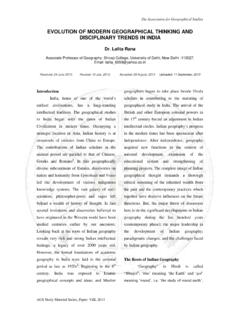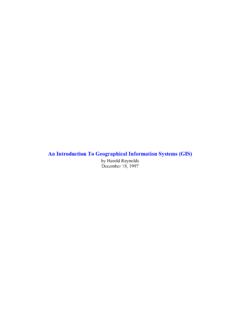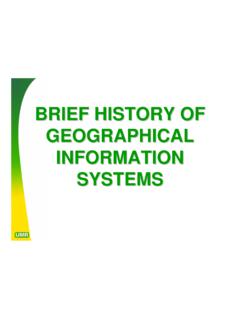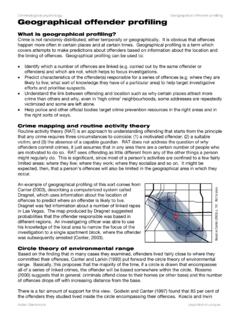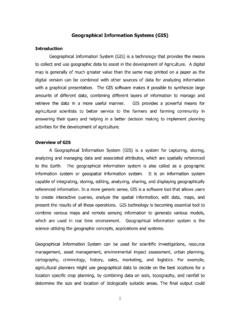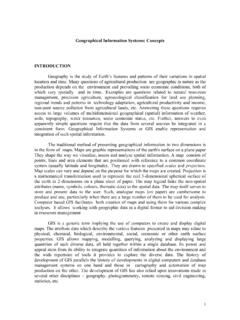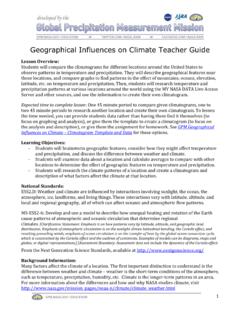Transcription of Remote Sensing and Geographical Information System (GIS)
1 The Association for Geographical Studies Remote Sensing and Geographical Information System (GIS). Dr. Punyatoya Patra Associate Professor, Aditi Mahavidyalaya, University of Delhi INTRODUCTION. Now-a-days the field of Remote Sensing and GIS has become exciting and glamorous with rapidly expanding opportunities. Many organizations spend large amounts of money on these fields. Here the question arises why these fields are so important in recent years. Two main reasons are there behind this. 1) Now-a-days scientists, researchers, students, and even common people are showing great interest for better understanding of our environment.
2 By environment we mean the geographic space of their study area and the events that take place there. In other words, we have come to realise that geographic space along with the data describing it, is part of our everyday world; almost every decision we take is influenced or dictated by some fact of geography. 2) Advancement in sophisticated space technology (which can provide large volume of spatial data), along with declining costs of computer hardware and software (which can handle these data) has made Remote Sensing and affordable to not only complex environmental /.
3 Spatial situation but also affordable to an increasingly wider audience. Remote Sensing . Meaning Literally Remote Sensing means obtaining Information about an object, area or phenomenon without coming in direct contact with it. If we go by this meaning of Remote Sensing , then a number of things would be coming under Remote Sensor, Seismographs, fathometer etc. Without coming in direct contact with the focus of earthquake, seismograph can measure the intensity of earthquake. Likewise without coming in contact with the ocean floor, fathometer can measure its depth.
4 However, modern Remote Sensing means acquiring Information about earth's land and water surfaces by using reflected or emitted electromagnetic energy. From the following definitions, we can have a better understanding about Remote Sensing : According to White (1977), Remote Sensing includes all methods of obtaining pictures or other forms of electromagnetic records of Earth's surface from a distance, and the treatment and 1. The Association for Geographical Studies processing of the picture data Remote Sensing then in the widest sense is concerned with detecting and recording electromagnetic radiation from the target areas in the field of view of the sensor instrument.
5 This radiation may have originated directly from separate components of the target area, it may be solar energy reflected from them; or it may be reflections of energy transmitted to the target area from the sensor itself. According to American Society of Photogrammetry, Remote Sensing imagery is acquired with a sensor other than (or in addition to) a conventional camera through which a scene is recorded, such as electronic scanning, using radiations outside the normal visual range of the film and camera- microwave, radar, thermal, infra-red, ultraviolet, as well as multispectral, special techniques are applied to process and interpret Remote Sensing imagery for the purpose of producing conventional maps, thematic maps, resource surveys, etc.
6 In the fields of agriculture, archaeology, forestry, geography, geology and others. According to the United Nations (95th Plenary meeting, 3rd December, 1986), Remote Sensing means Sensing of earth's surface from space by making use of the properties of electromagnetic wave emitted, reflected or diffracted by the sensed objects, for the purpose of improving natural resource management, land use and the protection of the environment. According to James (1996), Remote Sensing is the practice of deriving Information about the earth's land and water surfaces using images acquired from an overhead perspective, using electromagnetic radiation in one or more regions of the electromagnetic spectrum, reflected or emitted from the earth's surface.
7 So the stages of Remote Sensing include ( ): - A source of electromagnetic radiation or EMR (Sun). - Transmission of energy from the source to the surface of the earth, through atmosphere - Interaction of EMR with earth's surface. - Transmission of energy from surface to Remote Sensor mounted on a platform, through atmosphere - Detection of energy by the sensor. - Transmission pf sensor data to ground station - Processing and analysis of the sensor data - Final data output for various types of application 2. The Association for Geographical Studies Detection of energy by sensors Source of EMR.
8 Sensor data output Transmission of sensor data to ground station Transmission through atmosphere Data processing and analysis Interaction of EMR with earth surface : Stages of Remote Sensing History of Remote Sensing The knowledge about the history of Remote Sensing is necessary for better understanding of the subject and its scope, and also for future development, particularly for the welfare of human society. The development of Remote Sensing over time can be broadly divided into following six phases. Phase I (Up till 1920): Initial Phase Man always inquisitive about the things across a forest or a mountain, which he can not see directly.
9 So, since time immemorial man has always tried to reach greater heights, such as tree tops, mountains etc. to observe phenomena of his interest on the earth surface, viz. to decide habitat places, farming and other day-to-day activities. This inquisitiveness to get a bird's eye view prompted man to take photographs of earth from elevated platforms. So, the initial photographs of earth were captured from elevated platforms on the surface of the earth. However, the actual beginning of Remote Sensing can be traced back in 1958, when free balloons were used for photography by the French Gaspard Felix Tournachon (known as Nadar).
10 To photograph the village of Petil Becetre near Paris. In 1860, a part of Boston and Massachusetts were photographed from a captive balloon at 1200 feet height in USA. In 1909, 3. The Association for Geographical Studies the first aerial photograph was taken from an aero plane, piloted by Wilbur Write over Centocelli, Italy. World War I provided a boost in the use of aerial photography. During that time, aerial photographs were used for two purposes spying and mapping. Phase II (1920-1945): Development of Platforms and Sensors Improvement in aero planes, cameras, films etc.
